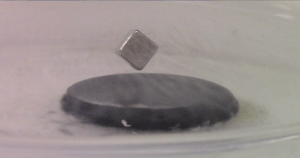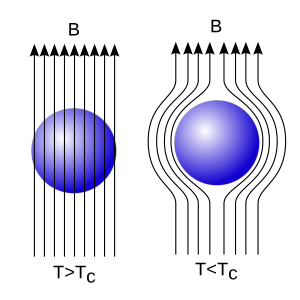 Induced currents in a superconducting disk cause a magnetic field that repels a small magnet and forces it to levitate. The disk is cooled down to superconducting temperatures using liquid nitrogen.
Induced currents in a superconducting disk cause a magnetic field that repels a small magnet and forces it to levitate. The disk is cooled down to superconducting temperatures using liquid nitrogen.
Equipment: (mostly in superconductor kit)
- Pyrex petri dish
- Superconducting thin disk (YBCO or BSCCO)
- Small cubical magnet
- Plastic tweezers (two pairs ideal)
- Magnetic track
- Styrofoam case
- Wood blocks to provide separation
- Liquid nitrogen
- Dewar
- Ladle
- Safety equipment (eye protection, gloves)
- Video camera
Demo 1:
- Place SC disk in the petri dish.
- Pour liquid nitrogen over it with the ladle.
- With tweezers, place the cube magnet above the disk. It will float a few millimeters above the disk!
Demo 2: (higher levitation and other effects)
- Instead of the thin disk, use the thick disk.
- Place the cube on the disk while everything is still at room temperature.
- Pour liquid nitrogen over both with the ladle (you will need more liquid nitrogen than for the thin disk).
- With tweezers, try removing the cube – it attracts the disk very strongly! If you look closely though, you’ll see the cube is still levitating very slightly.
- Remove the cube, place it aside, and flip over the disk.
- Replace the cube – it will now levitate even higher above the disk than in the first demo!
Demo 3: (Magnetic Track)
- Place the thin wood slats on top of the magnetic track and then place the superconductor that is in the styrofoam case on top. ( use the thicker superconductor)
- ladle in liquid nitrogen , wait, then repeat.
- Place top onto the styrofoam case and then remove the slats.
- The superconductor should be levitating at a constant distance above the track and glide freely back and forth. Feel free to spin the track around while the superconductor is levitating.
Explanation:
When cooled to below its critical temperature, a superconductor will expel all magnetic flux from within its volume. This is called the Meissner effect. In essence, when a permanent magnet (the cube) is brought close to a material, its magnetic field lines normally penetrate the material. However, when the material is a perfect superconductor, currents will be induced in the superconductor which exactly cancel the magnetic field from the permanent magnet.

Before being a superconductor, external magnetic filed lines penetrate the material, but below superconducting temperatures (T<Tc) the magnetic field lines go around the now superconducting material.
As such, the superconductor has zero magnetic field lines within its volume. The superconductor now contains a “mirror image” of the permanent magnet due to the induced currents and their resulting magnetic field. This repels the magnet, and the balance of the repulsive force pushing it up and the gravitational force pulling it down will cause the magnet to levitate above the superconductor.
In the 2nd demo, the superconducting disk is thicker and contains more impurities. As such, the physics is more complicated. When the cube is placed on the disk and both are cooled, currents are again set up in the superconductor that counteract the magnetic field from the cube. The cube will thus levitate slightly. However, due to impurities in this disk, some of the magnetic field lines from the permanent magnet that are able to penetrate the superconductor get trapped there – the superconductor now has a small field of its own that is in the same direction as the magnet (this is not the “mirror image” induced by the currents). This will strongly attract the permanent magnet.When the large disk is flipped over, both of the effects discussed above will now act to repel the magnet. The induced currents will still produce the repulsive “mirror image.” Those trapped field lines from before are still trapped – however, their direction was trapped too. The permanent field is now pointing opposite that of the cube magnet, and now also repels it! The levitation effect is thus even stronger now than in the first demo with the pure SC disk.
For the third demo, we will be using the same thicker disk. In this case, we have used wooden slats to separate the disk from the magnetic track when the disk is cooled. This will then cause the “mirror image” effect again. The currents this time will be set up according to the magnetic field which is now below the wood slats. This causes the disk to stay at the same height it was when the wood slats were below it. The disk will move freely above the track. It will hold the disk if the track is upside down and will keep it levitating at the same height above the magnets so that the flux will not change.
Notes:
- Video Camera is necessary for the first and second demo.
- YBCO = Yttrium Barium Copper Oxide
- BSCCO = Bismuth Strontium Calcium Copper Oxide